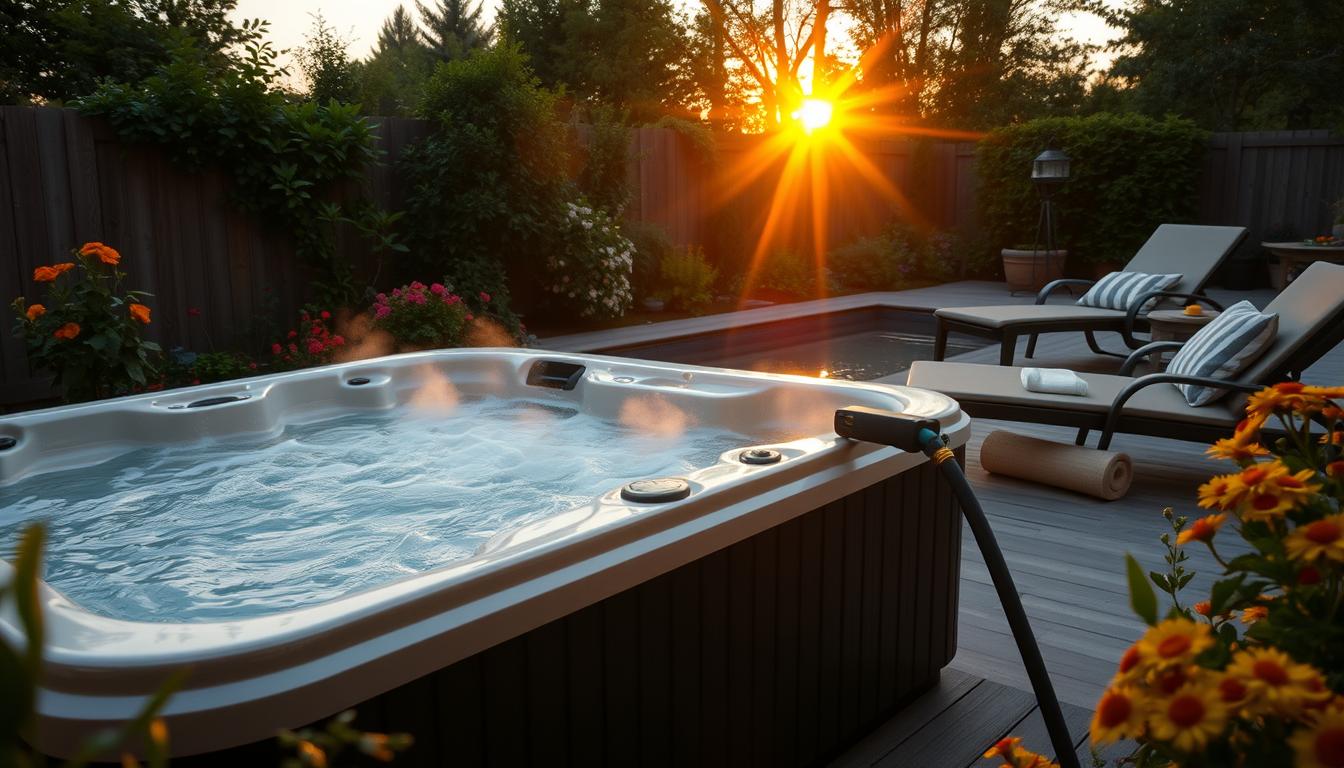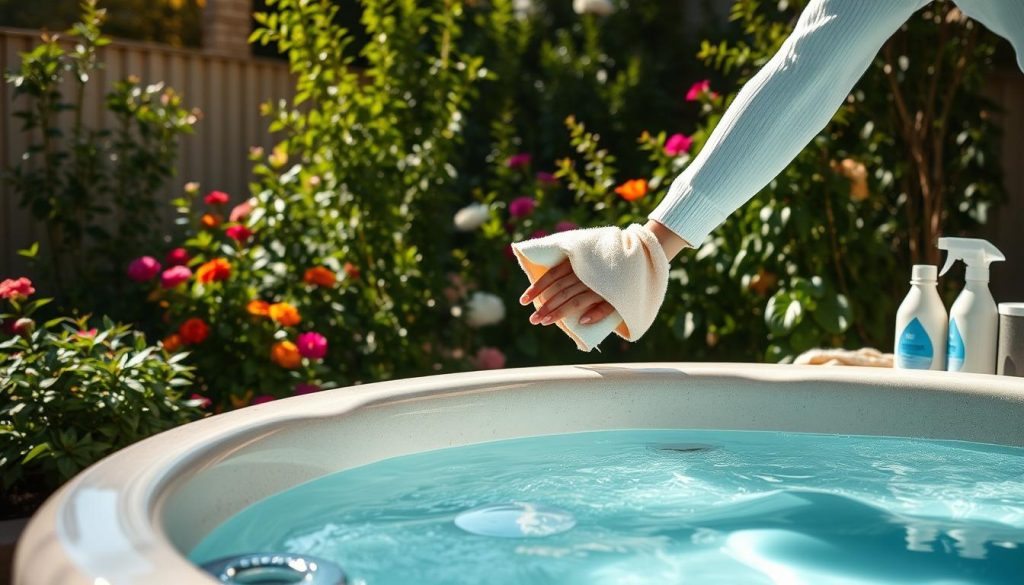
Regular hot tub maintenance is crucial for a clean and safe soaking experience. Draining, cleaning, and refilling your spa every few months is essential. This task keeps water chemistry balanced and prevents damage to your hot tub components.
The time to fill a hot tub depends on several factors. These include water capacity, flow rate, and hose size. Planning ahead ensures a smooth filling process.
This guide explores factors affecting hot tub filling time. We’ll provide expert tips for efficient filling and share typical filling durations. You’ll gain the knowledge to handle this maintenance task confidently.
Factors Affecting Hot Tub Filling Time
Several factors influence how long it takes to fill a hot tub. Knowing these elements helps estimate filling time and plan better. Let’s explore the key factors affecting hot tub filling speed.
Hot Tub Water Capacity
Your hot tub’s water capacity is crucial in determining filling time. Larger tubs need more time to fill than smaller ones. A standard 3-person tub holds about 350 gallons of water.
A larger 5-person model can hold up to 500 gallons. Knowing your tub’s capacity helps estimate filling time accurately.
Hot Tub Water Flow Rate
The water flow rate from your source directly impacts filling speed. A higher flow rate fills your tub faster. Most homes have a flow rate of 8 to 12 gallons per minute.
For optimal efficiency, aim for a flow rate of about 18 gallons per minute when refilling your hot tub.
| Hot Tub Size | Water Capacity (Gallons) | Filling Time at 12 GPM | Filling Time at 18 GPM |
|---|---|---|---|
| 3-Person | 350 | 29 minutes | 19 minutes |
| 4-Person | 400 | 33 minutes | 22 minutes |
| 5-Person | 500 | 42 minutes | 28 minutes |
Hot Tub Hose Size
The size of your filling hose affects filling time. A wider hose allows higher water flow, reducing overall filling time. Most people use a standard 5/8-inch garden hose.
Upgrading to a 3/4-inch hose can improve filling speed even more. Consider this option for faster results.
To optimize your hot tub filling process, try these tips:
- Ensure your water source provides adequate water pressure and flow rate.
- Use a hose with a larger diameter to increase the water flow rate.
- Keep the hose as straight as possible to minimize any kinks or restrictions.
- Regularly maintain and clean your hot tub to ensure efficient water circulation.
Consider these factors and use the suggested tips to streamline your hot tub filling. You’ll enjoy your spa experience faster and more efficiently.
Preparing Your Hot Tub for Filling
A clean hot tub is crucial for a great soaking experience. Proper maintenance extends your spa’s life and keeps it hygienic. Let’s explore the key steps to prepare your hot tub for filling.
Cleaning the Hot Tub Shell
Start by cleaning the hot tub shell with a non-abrasive cleaner. Focus on the waterline and jets, where contaminants often hide. Scrub thoroughly, then rinse completely to remove all cleaning product residue.

- Drain and refill your hot tub every 3-4 months, or more frequently if it’s subject to heavy use
- Test the water regularly with an at-home kit to ensure proper pH, alkalinity, and sanitizer levels
- Use a soft cloth or sponge to avoid scratching the shell’s surface during cleaning
- Address any stains or buildup promptly to prevent them from becoming more challenging to remove
Inspecting and Cleaning the Hot Tub Cover
While draining, inspect and clean your hot tub cover. The cover keeps water warm, prevents evaporation, and protects from debris. Clean the underside to prevent mold and bacteria growth.
Apply a UV-protectant to the top side to minimize fading and cracking. This helps maintain water quality and temperature while extending the cover’s life.
Regular hot tub cover maintenance not only extends the life of the cover but also helps maintain optimal water quality and temperature.
Keep these points in mind when caring for your hot tub cover:
- Inspect the cover for signs of wear and tear, such as cracks or tears, and replace it if necessary
- Ensure the cover fits securely to prevent heat loss and debris from entering the spa
- Allow the cover to air dry completely before placing it back on the hot tub to prevent mold growth
- Avoid using harsh chemicals or abrasive materials when cleaning the cover to prevent damage
| Maintenance Task | Frequency |
|---|---|
| Clean hot tub shell | Every 3-4 months or as needed |
| Inspect and clean hot tub cover | Monthly or as needed |
| Replace hot tub filters | Every 12 months or as needed |
| Test and balance water chemistry | Weekly or as needed |
Regular cleaning of your hot tub shell and cover ensures a top-notch spa. Follow these guidelines for a clean, safe, and enjoyable soaking experience for years to come.
How Long to Fill a Hot Tub: Average Filling Times
Filling a hot tub takes time. Most standard-sized hot tubs (300-400 gallons) fill in 1 to 1.5 hours using a garden hose. The size and water flow rate affect filling time.
Larger hot tubs may need up to 2 hours or more to fill. Monitor the water level during filling to avoid overfilling. Ensure the water reaches the manufacturer-recommended level for proper functioning.
| Hot Tub Size | Average Filling Time |
|---|---|
| Small (200-300 gallons) | 45 minutes – 1 hour |
| Medium (300-400 gallons) | 1 – 1.5 hours |
| Large (400-500 gallons) | 1.5 – 2 hours |
| Extra Large (500+ gallons) | 2+ hours |
After filling, heating the water comes next. Small acrylic hot tubs take 3 to 8 hours to heat. Larger hot tubs and swim spas need 12 to 24 hours.
Wooden hot tubs also typically require 12 to 24 hours to reach optimal temperature. Heating time varies based on tub size and starting water temperature.
On average, a hot tub heats up by 3-6°C (5-10°F) per hour when starting with cold water. Heating the water to a comfortable 38°C (100°F) can take approximately 5-8 hours.
To speed up heating, preheat water before adding it to the tub. Using a garden hose with hot water can help. Regular maintenance and a well-insulated cover reduce heating time and prevent heat loss.
Tips for Efficient Hot Tub Filling
Start by placing the hose in the filter housing. This fills the pipes and maintains system efficiency. Run the hose through the footwell and seats to prevent airlocks. Stop when water reaches the middle of the skimmer.
Balance the water chemistry after filling. Check and adjust pH, alkalinity, and sanitizer levels. Use a hose filter to remove impurities from the water source. This makes balancing easier and improves water quality.
Clean the filters 2-3 days after filling. This ensures optimal performance. Check and clean the hot tub cover too. Apply a protectant like 303 or Cover Shield to extend its life.
Replenish chemical supplies for high-usage periods. This helps maintain proper water balance. For very dirty tubs or those unused for long, consider filling, flushing, draining, and refilling.
Following these practices ensures a clean and safe soaking experience. You’ll enjoy your hot tub with minimal hassle and maximum pleasure.







